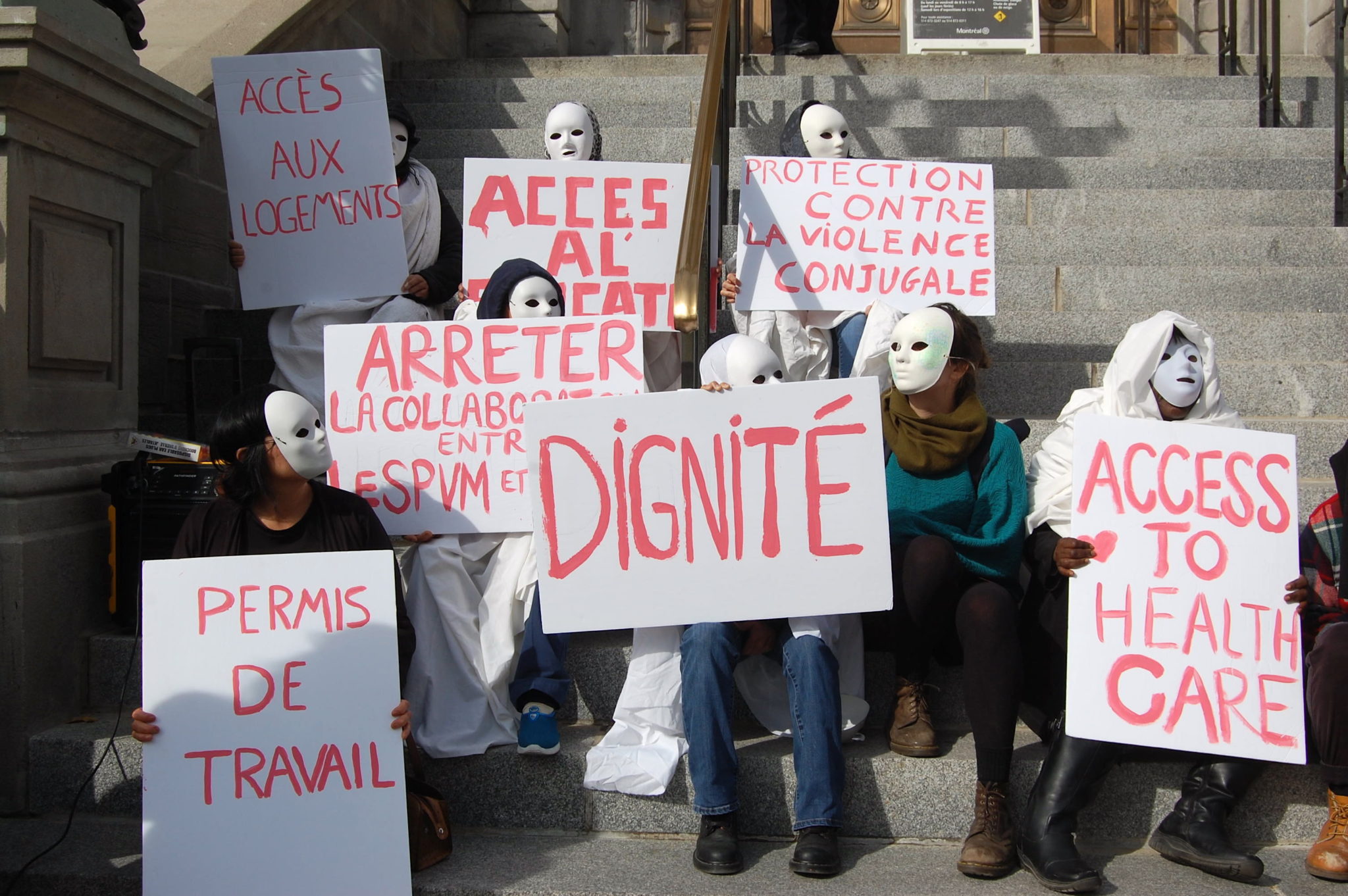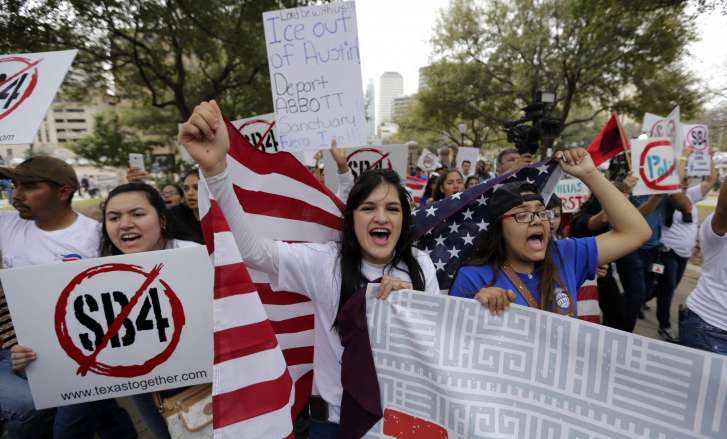Montreal, Quebec – Catherine (not her real name) has lived in Montreal since 2009. But this entire time, she’s been living under a cloud of uncertainty and fear without formal immigration status in Canada.“It’s terrible,” she told VICE News, her face hidden behind a white mask, during a protest outside Montreal city hall on Thursday alongside about two dozen activists and other women without status.The activists were calling on Montreal to stop city police from collaborating with the Canada Border Services Agency (CBSA), which is tasked with enforcing Canada’s immigration laws.A person without status can be anyone who overstays a visa, who has had an application for refugee status denied, or whose immigration status has been revoked.Originally from Latin America, Catherine said finding housing and employment and accessing health services have been the biggest challenges of life without status in Canada.“We live under stress and depression because there isn’t a work permit,” she said. “The most important thing is to work” in order to afford food, she added. Montreal Mayor Denis Coderre designated Montreal a sanctuary city in February. It followed Toronto, which passed a sanctuary city motion in 2013, and similar motions in Hamilton, Ontario in 2014, and Vancouver in 2016.In general, sanctuary cities put procedures in place to provide access to services to all residents regardless of their immigration status.But since Coderre’s declaration, individuals without status in Montreal “still do not have access to declared work, education, healthcare, housing and protection against sexual violence,” the Non-Status Women’s Collective of Montreal said in a statement.Activists also say that of the 2,872 calls Montreal police made to the Canadian Border Services Agency in 2016, 83 percent related to verifying immigration status. “This practice continues to this day,” the group said.“Coderre, Coderre,” the activists chanted on the steps of city hall, “Where is your sanctuary city?”An estimated 200,000 to 500,000 non-status immigrants live in Canada, primarily in the country’s largest cities, Toronto, Montreal and Vancouver, according to a recent report from Ryerson University analyzing Toronto’s sanctuary city policies.“It needs to force the two governments that are primarily responsible, in moral and legal terms, to actually do something,” he said.The debate over sanctuary cities has spread across North America in recent years.Supporters of sanctuary cities say the policies are needed to counter unjust and harsh immigration detention and deportation laws. Detractors say non-status immigrants stay in the country illegally and so they shouldn’t receive any city services or support.The push to create sanctuary cities gained momentum in the United States in 2014 when Barack Obama ramped up immigration enforcement, said Philip Wolgin, the managing director for immigration policy at the Center for American Progress, a left-leaning think-tank.
Montreal Mayor Denis Coderre designated Montreal a sanctuary city in February. It followed Toronto, which passed a sanctuary city motion in 2013, and similar motions in Hamilton, Ontario in 2014, and Vancouver in 2016.In general, sanctuary cities put procedures in place to provide access to services to all residents regardless of their immigration status.But since Coderre’s declaration, individuals without status in Montreal “still do not have access to declared work, education, healthcare, housing and protection against sexual violence,” the Non-Status Women’s Collective of Montreal said in a statement.Activists also say that of the 2,872 calls Montreal police made to the Canadian Border Services Agency in 2016, 83 percent related to verifying immigration status. “This practice continues to this day,” the group said.“Coderre, Coderre,” the activists chanted on the steps of city hall, “Where is your sanctuary city?”An estimated 200,000 to 500,000 non-status immigrants live in Canada, primarily in the country’s largest cities, Toronto, Montreal and Vancouver, according to a recent report from Ryerson University analyzing Toronto’s sanctuary city policies.“It needs to force the two governments that are primarily responsible, in moral and legal terms, to actually do something,” he said.The debate over sanctuary cities has spread across North America in recent years.Supporters of sanctuary cities say the policies are needed to counter unjust and harsh immigration detention and deportation laws. Detractors say non-status immigrants stay in the country illegally and so they shouldn’t receive any city services or support.The push to create sanctuary cities gained momentum in the United States in 2014 when Barack Obama ramped up immigration enforcement, said Philip Wolgin, the managing director for immigration policy at the Center for American Progress, a left-leaning think-tank. Under the Obama administration, the US put in place a program called “Secure Communities,” which established ties between local and state law enforcement agencies and Immigration and Customs Enforcement (ICE) for the purposes of deporting undocumented immigrants.“You could just be picked up for driving, for example, without a taillight, brought to a jail, and put into the [ICE] pipeline,” Wolgin told VICE News.“So you’d have people who had been in the community for 20 years, have families, have kids, and all of a sudden, they’re finding themselves deported for really not having done anything wrong.”Sanctuary city policies largely vary by county across the US.In some jurisdictions, local authorities will not hold someone for an extended period for ICE without a warrant or if the detainee hasn’t committed a serious crime. Some places will notify the federal government when a person is detained or released, but not turn people over to ICE directly, while others will assist ICE outright.“The debate has only gathered steam now under the Trump administration which has really super-charged even the already high enforcement that was present under the Obama administration,” Wolgin said.“Such policies make their cities and states less safe — public safety as well as national security are at stake — and put them at risk of losing federal dollars,” said US Attorney General Jeff Sessions in March, according to the New York Times.Critics of sanctuary cities, who often also speak out against liberal immigration policies more generally, also allege that sanctuary policies will make communities more dangerous.A report from the Center for American Progress found that sanctuary cities were actually safer: 33.5 few crimes were committed per 10,000 people in sanctuary cities than non-sanctuary cities. Supporters of sanctuary policies argue that undocumented residents will be more likely to report crimes to police if they aren’t afraid of being deported for coming forward.Household incomes are also higher and the poverty rate is lower in U.S. sanctuary cities compared to non-sanctuary cities, the report stated.According to Hudson, Canadian cities that have declared sanctuary policies, or are thinking about doing so, need to consult the public on what policies make sense for their own communities.“If you don’t have an existing line of communication and a working relationship with the community, you’re setting yourself up to fail,” Hudson said.
Under the Obama administration, the US put in place a program called “Secure Communities,” which established ties between local and state law enforcement agencies and Immigration and Customs Enforcement (ICE) for the purposes of deporting undocumented immigrants.“You could just be picked up for driving, for example, without a taillight, brought to a jail, and put into the [ICE] pipeline,” Wolgin told VICE News.“So you’d have people who had been in the community for 20 years, have families, have kids, and all of a sudden, they’re finding themselves deported for really not having done anything wrong.”Sanctuary city policies largely vary by county across the US.In some jurisdictions, local authorities will not hold someone for an extended period for ICE without a warrant or if the detainee hasn’t committed a serious crime. Some places will notify the federal government when a person is detained or released, but not turn people over to ICE directly, while others will assist ICE outright.“The debate has only gathered steam now under the Trump administration which has really super-charged even the already high enforcement that was present under the Obama administration,” Wolgin said.“Such policies make their cities and states less safe — public safety as well as national security are at stake — and put them at risk of losing federal dollars,” said US Attorney General Jeff Sessions in March, according to the New York Times.Critics of sanctuary cities, who often also speak out against liberal immigration policies more generally, also allege that sanctuary policies will make communities more dangerous.A report from the Center for American Progress found that sanctuary cities were actually safer: 33.5 few crimes were committed per 10,000 people in sanctuary cities than non-sanctuary cities. Supporters of sanctuary policies argue that undocumented residents will be more likely to report crimes to police if they aren’t afraid of being deported for coming forward.Household incomes are also higher and the poverty rate is lower in U.S. sanctuary cities compared to non-sanctuary cities, the report stated.According to Hudson, Canadian cities that have declared sanctuary policies, or are thinking about doing so, need to consult the public on what policies make sense for their own communities.“If you don’t have an existing line of communication and a working relationship with the community, you’re setting yourself up to fail,” Hudson said.
Advertisement

Advertisement
Hundreds of thousands without status
Toronto’s policy — known as “Access T.O.” — was meant to make it safe for people without status to access public city services without fear of being asked to prove their immigration status, or being turned over to border agents for detention or deportation.However, according to Graham Hudson, an associate professor at Ryerson University who co-authored the recent study on Access T.O., Toronto has put “virtually no money and resources” into actually implementing its sanctuary city policy.Hudson said about a dozen city staff members are well aware of the policy and are committed to it, compared to “the vast majority of the 50,000 employees of the city who either don’t know about the policy or who don’t know how to make the policy work.”He said staff needs training and the city should create jobs in each service area to deal specifically with the sanctuary city policy. The city should also go to the provincial and federal governments for help.“It needs to force the two governments that are primarily responsible, in moral and legal terms, to actually do something”
Advertisement
Sanctuary city policies spreading

Advertisement
California passed a state-wide sanctuary bill in October that prevents state and local law enforcement officials, including school police and security officers, from investigating, detaining or arresting people for immigration enforcement purposes.Vermont passed a law earlier this year limiting the ways in which local and state law enforcement cooperate with federal officials on issues of immigration.Meanwhile, Texas passed a bill that would outlaw sanctuary city policies. SB-4 would give local and state officials the power to ask a person’s immigration status during a routine traffic stop and cooperate fully with federal immigration enforcement officials.A federal judge temporarily blocked parts the bill in August.The measures come after the Trump White House threatened to withhold federal funding from states, municipalities, and local law enforcement agencies that do not report undocumented immigrants to federal authorities.Household incomes are also higher and the poverty rate is lower in U.S. sanctuary cities compared to non-sanctuary cities
Advertisement
Building ties to the community
It will be more difficult to convince residents in the community that sanctuary policies are sensible and in line with their needs, he said, and the city needs to be connected to non-status groups within the community to know what people need what services.“If the city just passes a policy … that they’ve cut and paste from the website of New York or San Francisco, it’s failing to really understand the nature of the problem and what solutions are required,” Hudson said.Catherine, meanwhile, said she was waiting for her application for refugee status on humanitarian and compassionate grounds to be processed.“I’m always thinking about what I’ll do tomorrow, about what I’ll do today,” she said, adding that she has developed depression because of the stress living without status has caused.“I hope [Coderre] keeps his promise,” she said.“I’m always thinking about what I’ll do tomorrow, about what I’ll do today”